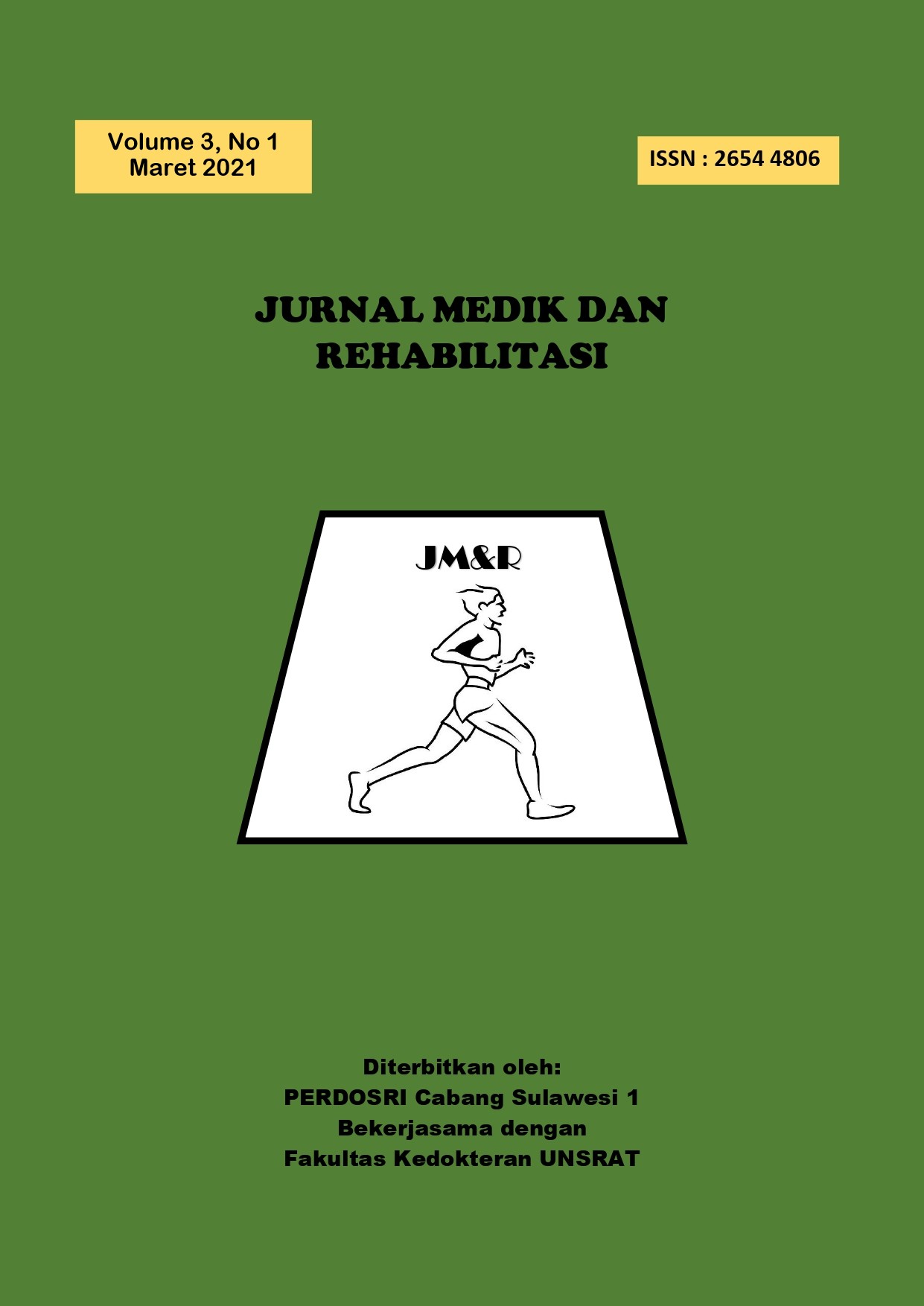Medical Rehabilitation in Patient With Right Transtibial Amputation: A Case Report
Abstract
Transtibial amputation is an amputation of the lower leg between the ankle joint and knee joint, also called below knee amputation (BKA). Currently amputation of the lower extremities reaches 85%-90% of all amputations and transtibial amputations are the most common type of amputation.In the United States, a lower limb amputation of 82% is caused by dysvascular causes such as peripheral vascular disease (PVD), Diabetes Mellitus (DM) or chronic venous insufficiency (CVI). Other causes are trauma (16.4%), malignancy (0.9%), and congenital anomalies (0.8%). The presence of knee joint in transtibial amputation has significance meaning in the rehabilitation program, allowing the patient to return near-normal gait functions with minimal physical limitations. Rehabilitation in patient with amputation must begin as soon as possible. The goal of rehabilitation is to maximize the patient’s capabilities, function, and independence. We report the rehabilitative course of a middle-aged female patient who did right transtibial amputation due to diabetic ulcer that showed good outcome.
Key Words: transtibial amputation, BKA, prosthetic, diabetic ulcer.
References
REFERENCES
Cucurullo SJ. Physical Medical and Rehabilitation Board Review. 3rd ed. New York: Demos Medical; 2015. Chapter 6. Prosthetics and Orthotics; p.477-496
Engstrom B, Van de Ven C. Therapy for Amputees. 3rd ed. Philadelphia: Churchill Livingstone; 2005. Chapter 15, Trans-tibial level of amputation; p. 187-202.
Lusardi MM, Nielsen CC. Orthotics and Prosthetics in Rehabilitation. 2nd ed. Philadelphia: Saunders Elsevier; 2013. Chapter 23, Transtibial Prosthesis; p. 622-51.
Vitriana. Rehabilitasi Pasien Amputasi Bawah Lutut dengan menggunakan Immediate Post Operative Prosthetic. Jakarta: Universitas Indonesia; 2002.
Standard of Care: Lower Extremity Amputation. The Brigham and Women’s Hospital, Inc. 2011.
Lusardi MM, Nielsen CC, Milagros J. Orthotics and Prosthetics in Rehabilitation. 3nd ed. Philadelphia: Saunders Elsevier; 2013. Chapter 17, Etiology of Amputation; p.455-68.
Delisa JA, Gans BM, Walsh NE, Robinson LR. Delisa’s Physical Medicine & Rehabilitation Principles and Practice. 5th ed. Philadelphia: Lippincott William & Wilkins; 2010. Chapter 74, Upper and Lower Extremity Prosthetics; p. 2017-49.
Transtibial Prosthetics. A Patient Care Manual for The New Amputee (phamplet). Available from: http://oandp.health.usf.edu/Pt/transtib_pros/transtib_pros.pdf
A Manual for the Rehabilitation of People with Limb Amputation. USA: World Health Organization United States Department of Defense Moss Rehab Amputee Rehabilitation Program; 2004
Engstrom B, Van de Ven C. Therapy for Amputees. 3rd ed. Philadelphia: Churchill Livingstone; 2005. Chapter 1, Introduction; p. 1-9
Lusardi MM, Pepe JL. Orthotics and Prosthetics in Rehabilitation. 2nd ed. Philadelphia: Saunders Elsevier; 2013. Chapter 22, Amputation Surgeries for the Lower Limb; p.498-531
Brammer CM. Manual of Physical Medicine and Rehabilitation. Philadelphia: Hanley & Belfus inc; 2002. Chapter 1, Amputation Rehabilitation; p.1-12
Tan JC, Horn SE. Practical Manual of Physical Medicine and Rehabilitation. Missouri: Mosby; 1998. Chapter 4.4, Prosthesis; p. 229-59.
Lovegreen W, Murphy PD, Smith KW, Stevens P, Webster J. Lower limb amputation and gait. In: Cifu XD (editor). Braddom’s physical medicine and rehabilitation. 5th edition. Elsevier. Philadelphia. 2016; 10:191-223.
Weiss LD, Weiss JM, Pobre T. Oxford american handbook of physical medicine and rehabilitation. Oxford University Press. 2010;278-80.
Sage RA, Pinzur M, Stuck R, Napolitano C. Amputation and rehabilitation of the diabetic foot. In: Veves A, Giurini JM, Logerfo FW (editor). The diabetic foot 2nd edition. Humana Press Inc. New Jersey. 2006;368-86.
Fitzsimons T, Clark A, Symonds A, Navarrete M, Saad N, Lees P et al. Physiotherapy Following Lower Limb Amputation: Protocols and Reference Material. Western Cluster; 2006
Lusardi MM, Nielsen CC. Orthotics and Prosthetics in Rehabilitation. 2nd ed. Philadelphia: Saunders Elsevier; 2013. Chapter 20, Postoperative and Preprosthetic Care; p.532-94
Energy expenditure [Internet] [cited 2016 Sep 3]. Available from: http://www.encyclopedia.com/doc/1O39-energyexpenditure.html
Gailey RS. Energy Expenditure of Trans-Tibial Amputees During Ambulation. Prosthetics and Orthotics International; 2004. 18: 84-91.
Handoyo R. Rehabilitasi penderita diabetes mellitus dengan amputasi anggota gerak bawah. Simposium pengelolaan penderita cacat akibat diabetes mellitus. Semarang. 2001;1-11.
Hanspal R. Amputee and prosthetic rehabilitation, standards and guidelines. 2nd edition. British Society of Rehabilitation Medicine. 2003;1-79
Engstrom B, Van de Ven C. Therapy for Amputees. 3rd ed. Philadelphia: Churchill Livingstone; 2005. Chapter 4, Immediate postoperative treatment; p. 42-55
The immediate post surgical period. A manual for below knee amputation. (phamplet). Available from: http://www.oandp.com/resources/patientinfo/manuals/3.htm
Silverman A, Neptune R. Muscle and Prosthesis Contributions to Amputee Walking Mechanics. Journal of Biomechanics; 2012. 45: 2271–2278.
Maguire M. Prosthetic Rehabilitation Manual: Transtibial Amputation. American Journal of Physical Medicine & Rehabilitation; 2013. 69 (3): 511-523.

